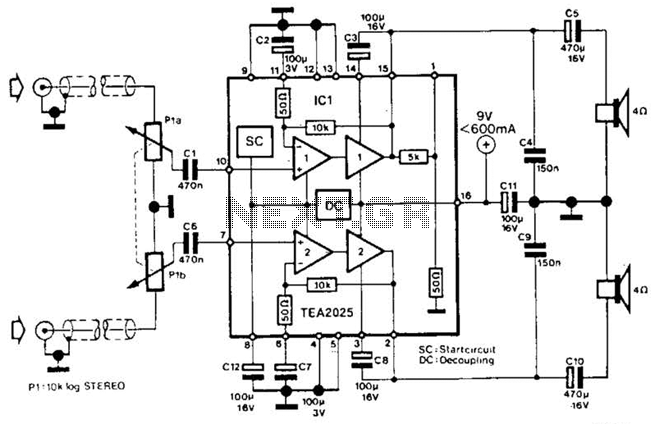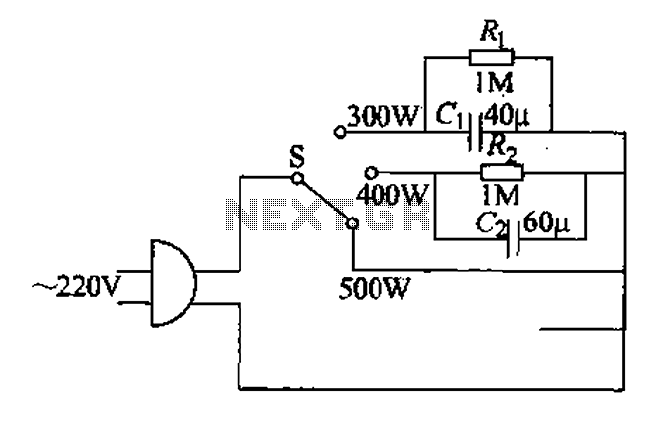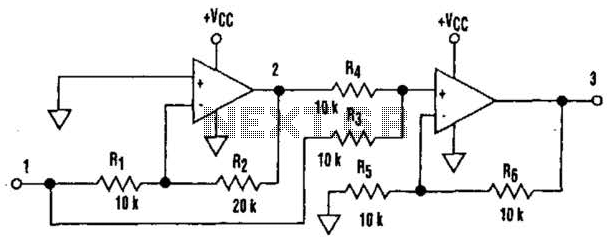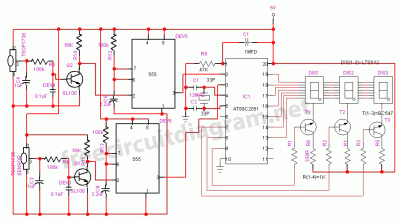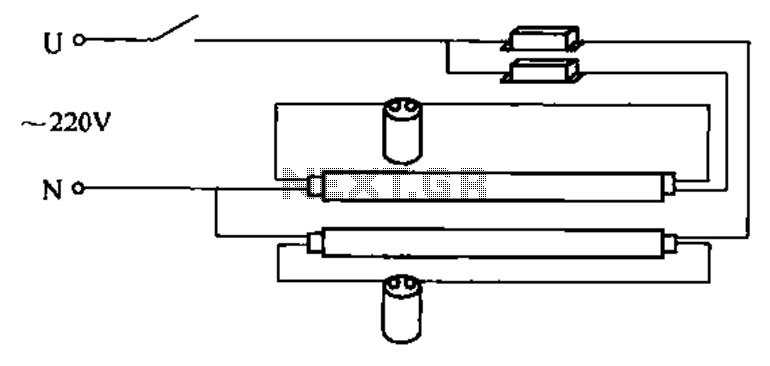
Handheld Oscilloscope Oscillator Circuit
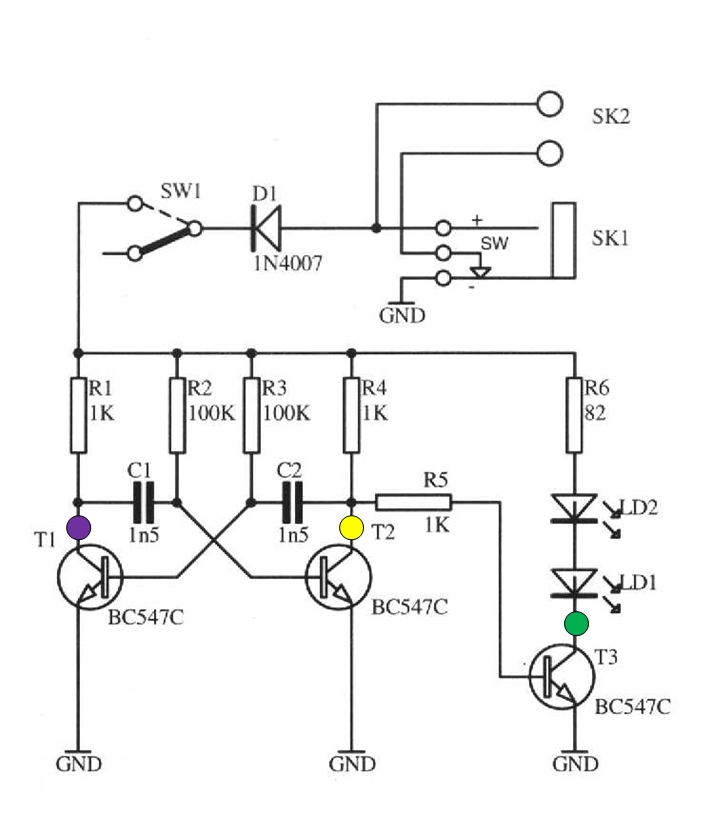
The schematic circuit presented below illustrates an infrared transmitter. The infrared beam is emitted in a nearly line-of-sight manner towards another device equipped with an infrared receiver. The displayed waveforms represent the output voltages from two intermediate stages (purple and yellow) and the output stage of the transmitter (green). To assess the voltage pulsed across the transmitting infrared LEDs, utilize the analog input of the iMSO-104 as one would with a standard oscilloscope. Secure the ground clamp to an appropriate reference point on the circuit and connect the oscilloscope probe lead to the collector leg of transistor T3, as indicated by a green dot in the schematic. The voltage oscillations of T1 and T2, represented in purple and yellow respectively, modulate the base voltage of T3, resulting in the pulsed output. Capacitor C1 charges only when T1 is activated and conducting, while T2 is deactivated with its base voltage elevated (indicating that the base voltage is approximately equal to the supply rail voltage). The oscillation frequency is determined by the values of four components: R1, R2, C1, and C2. The frequency is influenced by the values of these components in two distinct ways.
The infrared transmitter circuit operates by generating a modulated infrared signal that can be detected by a compatible receiver. The core components involved in this process include transistors T1, T2, and T3, which function as switches and amplifiers, and the passive components R1, R2, C1, and C2, which set the timing and frequency of the oscillation.
Transistor T1 is responsible for initiating the oscillation process. When T1 is turned on, it allows current to flow through the circuit, charging capacitor C1. The charging of C1 is critical as it influences the timing characteristics of the circuit. Once C1 is charged, it creates a voltage across it, which subsequently drives the base of transistor T2. The configuration of R1 and R2 determines the rate at which C1 charges and discharges, thus directly affecting the frequency of the oscillation.
Transistor T2 serves to further modulate the signal, with its output driving the base of T3. The interaction between T1 and T2 creates a feedback loop that sustains the oscillation. The output from T3, which is the final stage of the transmitter, generates the pulsed infrared signal that is emitted through the infrared LEDs.
The values of R1 and R2 primarily dictate the charge and discharge time constants of C1, while C2 can influence the stability and frequency of the oscillation by providing additional capacitance in the circuit. By adjusting these component values, the designer can fine-tune the frequency of the emitted infrared signal to match the requirements of the application, ensuring effective communication between the transmitter and the receiver.
Overall, the infrared transmitter circuit exemplifies a straightforward yet effective design for wireless communication, leveraging fundamental electronic components to achieve the desired functionality.The circuit in the schematic below is an infrared transmitter. The infrared beam is transmitted in a nearly line-of-sight pattern to another device with an infrared receiver. The plotted waveforms are the output voltages of the two intermediate stages (purple and yellow) and the transmitter`s output stage (green).
To measure the voltage pulsed acr oss the transmitting IR LEDs, use iMSO-104`s analog input as a traditional oscilloscope. Clip the ground clamp to a suitable anchor point on the circuit, and attach the scope probe lead to the collector leg of transistor T3, as indicated with a green dot in the schematic. The voltage oscillations of T1 and T2, purple and yellow respectively, drive the base voltage of T3 and create the pulsed output.
Capacitor C1 only charges when T1 is turned on and conducting, and T2 is turned off with its base voltage pulled high (meaning that the base voltage is essentially the same as the supply rail voltage) The oscillation frequency is set by the values of four components: R1 and R2, and C1 and C2. There are two ways that these component values affect the frequency. 🔗 External reference
The infrared transmitter circuit operates by generating a modulated infrared signal that can be detected by a compatible receiver. The core components involved in this process include transistors T1, T2, and T3, which function as switches and amplifiers, and the passive components R1, R2, C1, and C2, which set the timing and frequency of the oscillation.
Transistor T1 is responsible for initiating the oscillation process. When T1 is turned on, it allows current to flow through the circuit, charging capacitor C1. The charging of C1 is critical as it influences the timing characteristics of the circuit. Once C1 is charged, it creates a voltage across it, which subsequently drives the base of transistor T2. The configuration of R1 and R2 determines the rate at which C1 charges and discharges, thus directly affecting the frequency of the oscillation.
Transistor T2 serves to further modulate the signal, with its output driving the base of T3. The interaction between T1 and T2 creates a feedback loop that sustains the oscillation. The output from T3, which is the final stage of the transmitter, generates the pulsed infrared signal that is emitted through the infrared LEDs.
The values of R1 and R2 primarily dictate the charge and discharge time constants of C1, while C2 can influence the stability and frequency of the oscillation by providing additional capacitance in the circuit. By adjusting these component values, the designer can fine-tune the frequency of the emitted infrared signal to match the requirements of the application, ensuring effective communication between the transmitter and the receiver.
Overall, the infrared transmitter circuit exemplifies a straightforward yet effective design for wireless communication, leveraging fundamental electronic components to achieve the desired functionality.The circuit in the schematic below is an infrared transmitter. The infrared beam is transmitted in a nearly line-of-sight pattern to another device with an infrared receiver. The plotted waveforms are the output voltages of the two intermediate stages (purple and yellow) and the transmitter`s output stage (green).
To measure the voltage pulsed acr oss the transmitting IR LEDs, use iMSO-104`s analog input as a traditional oscilloscope. Clip the ground clamp to a suitable anchor point on the circuit, and attach the scope probe lead to the collector leg of transistor T3, as indicated with a green dot in the schematic. The voltage oscillations of T1 and T2, purple and yellow respectively, drive the base voltage of T3 and create the pulsed output.
Capacitor C1 only charges when T1 is turned on and conducting, and T2 is turned off with its base voltage pulled high (meaning that the base voltage is essentially the same as the supply rail voltage) The oscillation frequency is set by the values of four components: R1 and R2, and C1 and C2. There are two ways that these component values affect the frequency. 🔗 External reference

